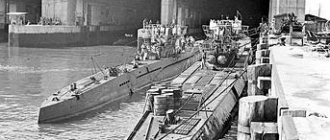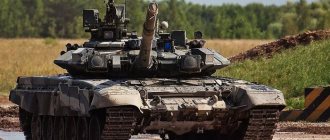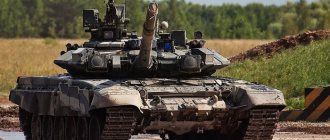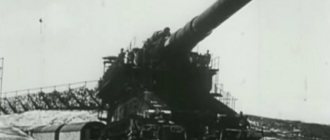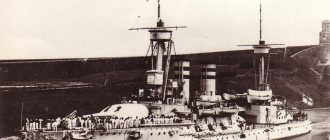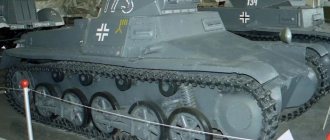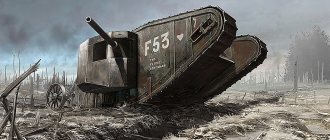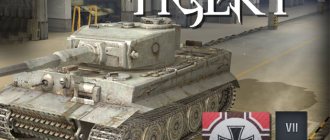In the mid-1930s, Nazi Germany quickly freed itself from the restrictions of the Versailles Treaty, which prohibited it from having powerful armed forces. Development of the future Bismarck began in 1934. The Germans were preparing for a new major war, and no one was going to enter it without a strong fleet. However, the extensive shipbuilding program was impossible for Germany: the Nazis could not recreate the mighty Kaiser’s fleet. However, they firmly intended to build a fleet capable of destroying at least a French squadron. In 1936, as part of plans to build a new fleet, two battleships that went down in the history of naval warfare were laid down - Bismarck and Tirpitz.
"Bismarck" was intended for the classic battle of battleships. It had heavy armor, low vulnerability to flat cannon fire, and powerful weapons, primarily, however, adapted for close combat: the elevation angle of the guns remained small. This choice is associated with the expectation of battles in conditions of poor visibility at short distances.
However, things were worse with the concept of using new battleships. France in the 30s was considered a serious enemy, but the Germans had a vague idea of what to do if they also had to fight against the mighty British fleet. Meanwhile, this is exactly what happened in reality.
The Bismarck was finally completed and commissioned on August 24, 1940. The ship was commanded by Captain Zur See Ernst Lindemann; the crew consisted of more than two thousand people. By this point, France had surrendered; the Germans no longer needed to destroy its fleet. But at the very beginning of the new world war, Britain declared war on the Nazis, and now the Germans were left with a well-prepared, but fatally small fleet.
The inability to secure a landing on Albion forced the abandonment of the planned Operation Sea Lion. Hitler turned to the crazy idea of defeating the Soviet Union, and the tasks of the German fleet became vague. The solution came in April 1941, when Admiral Raeder decided to turn to raid warfare. Although it was later said that this was the original purpose of the Bismarck, in reality it would have been simply wasteful to create such a powerful and expensive ship for operations against convoys. The battleship's operations against convoys were conceived, oddly enough, simply due to the lack of more suitable tasks that could be assigned to it.
Be that as it may, a raid by a combat detachment led by the Bismarck was planned. He was to be supported by the cruiser Prince Eugene. Initially, two more battleships, the less powerful Scharnhorst and Gneisenau, were planned to go to sea, but due to technical problems they remained at the bases. The operation of the two remaining warships was led by Rear Admiral Lutyens, who went to sea on the Bismarck.
On May 19, "Bismarck" and "Prince Eugene" headed around Britain and Iceland to the North Atlantic.
The last campaign of "Bismarck" - in life and on the screen
75 years ago, on May 18, 1941, the largest battleship of the Third Reich, the Bismarck, set out on its first military campaign, which became its last. The details of this campaign were so incredible and exciting that many books and films were dedicated to them. The most famous feature film about the fate of the ship was the film “Sink the Bismarck!”, released in 1960. How different is the real story of Bismarck from the cinematic one?
Birth
Germany began to think about the appearance of the future super-battleship back in 1932. Initially, its displacement was supposed to be 35,000 tons, and its armament was to be eight 330 mm guns. However, “during the journey the dog could grow up,” and on February 14, 1939, the Bismarck, over 240 m long, with a maximum displacement of almost 51,000 tons and four towers with a pair of the latest 380-mm cannons in each, was solemnly launched - in the presence of Hitler and the commander of the fleet, Grand Admiral Raeder.
The dimensions of almost every part of the Bismarck were amazing. Each shell for the ship's guns weighed 800 kg. 12 high-pressure boilers provided the huge battleship with a speed of 30 knots. The main belt of the ship consisted of welded plates of cemented armored steel KS with a thickness of 320 mm. The quality of this steel was one of the best in the world - only the British with the SA brand had better quality armor. The total weight of the armor was an impressive 18,700 tons - or 40% of the project's combat displacement.
"Bismarck" at the base in Kiel. The image allows you to estimate the size of the ship www.steelnavy.com
Bismarck goes into battle
By May 1941, German battleships already had experience of successful raids in the Atlantic. During Operation Berlin from January 22 to March 22, 1941, the battleships Scharnhorst and Gneisenau were able to sink 22 ships with a total displacement of more than 115,000 tons. Grand Admiral Raeder, naturally, was eager to repeat the success. According to the “Exercise on the Rhine” plan, “Bismarck” and support ships were supposed to leave German ports, and “Scharnhorst” and “Gneisenau” - from French Brest. Then they jointly began hunting convoys throughout the North Atlantic. The captain of the Bismarck was Ernst Lindemann, and the entire ship group was commanded by Admiral Gunther Lütjens.
However, circumstances interfered with the original plans. First, the superheater tubes at Scharnhorst failed and required several months of repairs. Then the Gneisenau “caught” a torpedo from a flying Beaufort - and the Bismarck was left only with the heavy cruiser Prinz Eugen paired. But then the Prinz Eugen, on an ordinary passage from Gotenhafen to Kiel, was blown up by a magnetic mine. We had to wait for it to be repaired - Raeder feared that the United States would soon enter the war (then there would immediately be much more enemy ships in the ocean) and did not want to cancel the operation for good.
As a result, the Bismarck went to sea on the night of May 19 (the Prinz Eugen did the same a little earlier). The opponents very quickly learned about the super-battleship's departure for the hunt - already on May 20, at about 15:00, the Swedish cruiser Gotland transmitted a radiogram about a meeting with the German squadron. The radiogram immediately reached the British. On May 21, the reconnaissance Spitfire was able to photograph both the Bismarck and the Prinz Eugen.
The British notified the heavy cruisers Norfolk and Suffolk, as well as the light cruisers Birmingham and Manchester, of their discovery. A squadron of the newest battleship Prince of Wales (even shipyard workers remained on board), the battle cruiser Hood and six destroyers came out to intercept the enemy. The battleship King George V remains in reserve for now, at the base in Scapa Flow.
Meanwhile, on the evening of May 21, Bismarck, taking advantage of the fog, moved to the Arctic. On May 22, having learned that the Germans were already somewhere at sea, the King George V and the aircraft carrier Victorious with 5 light cruisers also left the base. Then the battlecruiser Repulse from Clyde, the battlecruiser Renown and the aircraft carrier Ark Royal from Gibraltar joined the search for the Bismarck.
First blood
On the evening of May 23, first the heavy cruiser Suffolk, and then the Norfolk, detected a German squadron by radar. The next morning, a battle began in the Denmark Strait between Greenland and Iceland. The Hood and Prince of Wales were the first to discover the enemy and open fire. At 5:55 Bismarck responded. And suddenly, at 6:01, after the fifth salvo of the Bismarck...
The death of "Hood"
Hood, until recently the largest ship of the British fleet, its beauty and pride, and with it almost one and a half thousand (more precisely, 1,415) crew members almost instantly disappeared into the sea. Only three people were saved. To this day, fleet enthusiasts are fiercely arguing about what destroyed the Hood. Trajectories are lined up showing exactly how an armor-piercing shell, when turning a battleship, could pierce the armor belt, the bevel of the armored deck and the roof of the magazine of 102-mm shells. Maybe it went through the turbine compartment? Or did you fall into the water and simply “dive” under your belt? Such a shell, but unexploded, was found in the Prince of Wales. The result (also probable): the gunpowder in the cellar flared up, hot gases rushed through the ventilation shafts. Tens of tons of gunpowder from the main magazine caught fire, and in a few seconds the ship’s hull was broken.
Two minutes later, the Prince of Wales, having received several hits, covered itself with a smoke screen and left the battle. The Bismarck escaped with three hits: one broke the pipeline to the fuel tanks, the second disabled the catapult for the ship's seaplane, and the third damaged the steam line in the turbogenerator compartment. As a result, the ship's speed dropped to 28 knots, and fuel flowed overboard. After thinking, Admiral Lutyens decided to return the Bismarck to Brest for repairs, and release the Prinz Eugen for independent hunting.
The next evening at 22:00, the Bismarck was attacked by eight Swordfish torpedo bombers from the aircraft carrier Victorious, under the cover of six Fulmar fighters. Although the pilots took off from the deck for the first time in their lives, one of them was able to hit the battleship. But at night the British cruisers... lost the Bismarck on radar. Ironically, the battleship was receiving radar radiation, and Lutyens, thinking that the British knew its location anyway, sent a long radio message about the state of affairs on board. The British were able to find the Bismarck's direction, but they incorrectly put the data on the map. As a result, almost fifty ships spent many hours searching for the Bismarck in places other than where it actually sailed. And only on the morning of May 26, the patrol Catalina again discovered the elusive battleship.
But now the British ships did not have time to overtake the Bismarck. The last hope remained - in carrier-based aircraft. 14 Swordfish from the aircraft carrier Ark Royal fired 11 torpedoes... at their own cruiser Sheffield. Fortunately, the magnetic fuses of several torpedoes went off too early, and the ship managed to dodge the rest. And only the second attack hit the real enemy. Of the 13 torpedoes, two or three hit the target. But only one became fatal - it tightly jammed both rudders of the battleship.
At night, the Bismarck was attacked by British destroyers. Having fired 14 torpedoes at the uncontrollable ship, they... didn’t hit even once. And in the morning the British lost the battleship again, but were soon able to find it again.
Death of Bismarck
The British threw the battleships Rodney and King George V into the final battle with 406 mm and 356 mm guns. The first salvo at 8:47 was fired by Rodney. Less than an hour later, the British managed to disable all the main caliber turrets of the Bismarck. Soon the rest of his guns fell silent. The German battleship was a burning wreck. "Rodney", trying to deal with the enemy as quickly as possible before the fuel ran out, even fired at the helpless "Bismarck" with large-caliber 24.5-inch torpedoes, and missed. Although the guns of the King George V and Rodney did not always work as expected, together with the heavy cruisers Norfolk and Dorsetshire they fired almost three thousand (more precisely, 2876) shells with a caliber from 133 to 406 mm and achieved approximately 300–400 hits. Flying shells could be seen even with the naked eye.
The first explosions of British shells
https://www.kbismarck.com/
The surviving Bismarck officers decided to scuttle the ship with explosive charges. After 10:20 the charges detonated, and the Bismarck began to slowly roll to port. Meanwhile, Dorsetshire launched a torpedo attack: two torpedoes hit the starboard side, then another was fired at the left side. At 10:39, the crippled battleship capsized and sank. German submarines and aircraft never came to his aid. The British managed to save only 115 people; more than 2,100 died in the water.
On screen and underwater
After the war, the time came for filmmakers. Released in 1960, the film “Sink the Bismarck!” has received much praise for its accuracy in depicting historical events. This is not surprising - for example, Edward Murrow, a journalist known for his radio reports from wartime London, played... himself in the film. Esmond Knight, who played the captain of the Prince of Wales, was on board the same ship in 1941 and was wounded in the same battle. The real chronicle of the Bismarck's launch into the water and recordings of battles were used. Views from the “inside” of the ships were filmed on the Vanguard, the only British battleship that survived to this time.
Edward Murrow
The codebreaking with the help of Bletchley Park analysts remained secret until 1975, so it is not mentioned in the film. But the movie accurately depicts the Catalina flying boat that found the Bismarck. They did not keep silent about the attack on their own ship. The complexity of the work of the British headquarters, which determines the actions of the ships, is perfectly depicted.
To enhance the drama on the screen, the British “suffered” even more serious losses than in reality: the Bismarck shoots down two Swordfish with anti-aircraft fire (in reality, several aircraft were damaged). It is curious that the scene where the discovery and rescue of a boat with three pilots is reported is completely accurate. Two Fulmar fighters from the Victorias, having spent fuel, landed in the sea, and three people were rescued.
Also, the battleship, having already received the fatal torpedo, repels the attack of the destroyers and sinks one of them, the Solent. There was no such destroyer in the British fleet, and not a single destroyer was lost. But otherwise, the events after the defeat of the helm would have looked like a pure “one-goal game.”
"Bismarck" on the silver screen
Admiral Lutyens in the movies is shown to be an ardent admirer of Hitler and a convinced, if not fanatical, Nazi. With all his enthusiasm, he joyfully sets up the team for a grandiose and victorious hunt for convoys. However, surviving crew members described the real Lutyens as a brooding and even gloomy person. In life, the admiral insisted on postponing the operation until the repair of the Scharnhorst was completed or even the Tirpitz was commissioned. Lutyens also did not want to engage in battle with the Hood and the Prince of Wales (intercepting convoys was much more important than dueling) - and in the movies it was he who ordered Lindeman to open fire.
And only many years after the war were submarines able to reach the remains of Hood and Bismarck. Judging by the position of the wreckage, the Hood actually began to turn just before the explosion. It was declared a war grave in 2002 and all further work ceased.
"Bismarck" at the bottom
https://www.kbismarck.com/
In 2002, the famous film director and deep-sea diving enthusiast James Cameron organized an expedition to the Bismarck on the ship Akademik Mstislav Keldysh. With the help of the Mir-1 and Mir-2 bathyscaphes, it was possible to establish the nature of the damage to the hull. It follows that, probably, the doomed ship was eventually sunk by its own crew (as the surviving crew always claimed).
Sources and literature:
- https://www.imdb.com/
- https://www.kbismarck.com/
- https://www.scharnhorst-class.dk/
- Evans, Alun. Brassey's Guide to War Films. Dulles, Virginia: Potomac Books, 2000.
- Burkhard von Müllenheim-Rechberg. Battleship Bismarck. - M., Eksmo, Yauza. 2006.
- Dashyan A. Killers of Bismarck. Battleships Nelson and Rodney. M., Collection, Yauza, Eksmo, 2010.
- Kofman V. The Death of the Lord of the Seas. Battlecruiser Hood. - M., Collection, Yauza, Eksmo, 2009.
- Malov A. A., Patyanin S. V. Battleships “Bismarck” and “Tirpitz”. — M.: Eksmo, 2014
Construction
The ship's keel was laid on July 1, 1936 at the German shipyard Blohm & Voss. On February 14, 1939, the battleship left the slipways. When the ship was launched, the granddaughter of Prince Bismarck (the ship got its name in his honor) was present, who, according to tradition, “christened” the ship with a bottle of champagne, as well as the current Adolf Hitler. On August 24 of the following year, Ernest Lindemann was appointed captain of the battleship Bismarck. Testing of the vessel and its equipment continued until the beginning of 1941.
Memory
The warships Bismarck and Tirpitz are often compared to the civilian liners Titanic and Olympic. In both cases, the ship that died on its first voyage gained worldwide fame, while the ship that served much longer remained in the shadows. In 1960, director Lewis Gilbert shot the film “Sinking the Bismarck.”
The place where the history of the battleship Bismarck ended was discovered only on June 8, 1989, thanks to the efforts of Robert Ballard, who had previously found the same Titanic. According to international law, this place is considered a war grave. From the moment of the sinking to this day, six expeditions have been organized there. Also in 1989, Patrick Prentice shot another documentary about the secrets of the battleship Bismarck. In 2002, the director of the film “Titanic” James Cameron also made his contribution to the memory of the ship. Using the Russian Mir submersibles, he carried out underwater filming for the film “The Bismarck Expedition.”
Specifications
The dimensions of the ship are impressive: length - 251 m, width - 36 m, height from the keel to the first deck amidships - 15 m. The standard displacement of the battleship Bismarck was 41.7 thousand tons, and the total displacement was 50.9 thousand tons. The ship's armor was no less impressive: 70% of its length was covered with a main armor belt with a thickness of 170 to 320 mm. The conning tower and main caliber gun turrets of the battleship Bismarck received even thicker armor – 220-350 and 360 mm, respectively.
The ship's armament was no less serious. It consisted of eight 380 mm main caliber guns, 12 150 mm auxiliary guns and a large number of anti-aircraft artillery. Each of the main caliber towers had its own name: the bow ones were called Anton and Brun, and the stern ones were Caesar and Dora. Despite the fact that the British and American battleships of that time had a slightly larger main gun, the Bismarck's gun posed a serious threat to them. A perfect aiming and fire control system, as well as high quality gunpowder, allowed the Bismarck to penetrate 350 mm armor from 20 kilometers.
The ship's power plant was represented by twelve Wagner steam boilers and four turbo-gear units. Its total power was more than 150 thousand horsepower, which allowed the ship to accelerate to 30 knots. At an economical speed, the ship could travel more than 8.5 thousand nautical miles. Such characteristics of the battleship Bismarck were an outstanding achievement of German engineers. The ship's crew consisted of 2,200 sailors and officers.
Chase
The Prince of Wales, together with the ships Norfolk and Suffolk that approached it, continued to pursue the German flotilla. The death of the Hood was taken extremely painfully by the British Admiralty. Later, a special commission was established to investigate her circumstances. Soon, most of the British navy based in the Atlantic, including convoy guard ships, were involved in the hunt for the battleship Bismarck.
On May 24, at the beginning of seven in the evening, in thick fog, the Bismarck turned towards its pursuers. There were no hits during the short exchange of salvos, but the British had to dodge. As a result, the Prinz Eugen vessel successfully broke contact. Ten days later it arrived in Brest, France. On May 24, at 10 p.m., Admiral Lutyens informed the command that due to a lack of fuel, his battleship could not continue trying to fight off the enemy's pursuit and was forced to go straight to Saint-Nazaire. Meanwhile, Admiral Tovey gave the order to the aircraft carrier Victories to close the distance. At the beginning of the eleventh hour, 9 torpedo bombers of the Swordfish model took off from the ship. Despite massive resistance, they still managed to accurately hit the side of the enemy ship once. In this case, the impressive size of the battleship Bismarck played a cruel joke on him.
By 2:30 all aircraft had returned to the aircraft carrier. "Bismarck" practically did not suffer from this raid, since the only accurate hit was directly on the main armored belt. However, the German crew still lost one person. This was the first loss of the Nazis during the entire campaign. To protect against torpedo bombers, the crew of the battleship Bismarck had to use all anti-aircraft weapons and some large-caliber guns. To make it more difficult for the torpedo bombers to aim, the ship increased its speed and tried in every possible way to evade the fire. Although the British attack did not affect the condition of the ship, the sudden maneuvers aggravated some of the problems remaining from previous attacks. Thus, the patches-sails placed over the hole in the bow of the ship came off, as a result of which the leak intensified, and with it the trim on the bow intensified.
On the night of May 25, Bismarck's pursuers began zigzagging, apparently wary of the prospect of falling prey to German submarines. Taking advantage of this, the battleship accelerated and broke contact. At 4 o'clock in the morning this was officially reported by the ship "Suffolk".
Result
The last battle of the Bismarck illustrated how difficult it is to hit a battleship even with numerical superiority and the presence of equipment with similar characteristics. On the other hand, the decisive blow to the huge ship was dealt by one torpedo from a small aircraft. Therefore, the main conclusion that the military drew from the death of the battleship Bismarck was that battleships had ceded their dominant position in the fleet to aircraft carriers.
Soon the German naval command abandoned the raider operations of the surface fleet in favor of unrestricted submarine warfare. The second battleship of the Bismarck class, the battleship Tirpitz, did not launch a single salvo attack on enemy ships during all the years of the war. However, the British had to tie up an impressive force of sea and air fleet in case the battleship based in Norway did go to sea.
Attack of the Swordfish
After the battle in the Denmark Strait and the death of the Hood, a real threat arose that the Bismarck would be able to break through to the vastness of the Atlantic, where it would be extremely difficult to find it. Therefore, Admiral Tovey sent the aircraft carrier Victorious into battle so that it would attack the German battleship with its torpedo bombers. On the aircraft carrier, which had not yet had time to gain combat experience, there were only nine attack aircraft - these were old Swordfish biplanes of the 825th squadron. There were six more Fulmar fighters from 802 Squadron, while the rest of the hangar space was occupied by partially dismantled Hurricane fighters that were to be delivered to Malta. Soon, nine torpedo bombers rose from the deck of the aircraft carrier and disappeared into the clouds hanging low over the ocean. The squadron was led by Lieutenant Commander Eugene Esmond. Soon the Swordfish found their target. At exactly midnight, three torpedo bombers simultaneously dropped torpedoes, attacking the battleship from the port side, aiming for the midsection area. The next three torpedoes, dropped a minute later by the 2nd group, were aimed at the bow of the ship. The 7th vehicle aimed its torpedo at the bow superstructure, and the 8th Swordfish dropped a torpedo from the starboard side. It was this last torpedo that hit the starboard side of the battleship in the area of the navigation bridge. The fighter pilots covering the attack of the torpedo bombers reported that they saw black smoke rising from the bow, and he himself slowed down. This hit turned out to be fatal. For the Bismarck, it was with him that a long series of failures began, which led to the death of the ship. The tiller compartment on the battleship was flooded. The diver who descended examined the stock of the damaged rudder and found out that it was impossible to repair it in field conditions. Having survived the battle against two powerful opponents, the huge ship was seriously wounded by an old biplane, outdated by the beginning of the war. As a result, the German ship lost its maneuverability and speed and was forced to take a course that led it directly to the English squadron. And so it happened.
Submarine operations
The German submarines, which were hunting enemy convoys in the Atlantic as part of the “wolf packs,” were notified that the Bismarck and the Prinz Eugen were leaving for the campaign.
On May 24, the submarine received a radio message about the battleship’s victory over the Hood, as well as instructions to continue to be guided by orders taking into account the position of the Bismarck.
On May 25, the submarine U-557, several hundred miles from the battleship, discovered and attacked a large convoy. The next day, she was ordered to share her coordinates with other submarines for a joint strike.
Early on the morning of May 27, all submarines that had a supply of torpedoes remaining were ordered to head to the Bismarck at maximum speed. The submarines received the order 8 hours late: it was signed at 10 pm the previous day. At the time of signing, most of the boats took part in the attack on the convoy, were hiding from the escorts and, for technical reasons, could not receive the order. In addition, at this moment, the submarines pursuing the convoy pulled away from the Bismarck to the north. On May 27 at 11:25, headquarters informed the submarines that the battleship had become the victim of a massive enemy attack. All nearby submarines were ordered to go to rescue the ship's crew members.
Arriving at the scene of death, the submarines discovered a huge amount of debris and a thick layer of oil on the surface. After a day of searching, they returned to their patrol areas.
Detection
The German battleship Bismarck apparently continued to receive Suffolk radar signals, and already at 7 a.m. on May 25, Admiral Lutyens informed the command that the pursuit was continuing. In the evening of the same day, the command demanded from the Bismarck data on its location and speed and indicated that the British most likely had lost sight of the German ship. Lutyens did not send a response radiogram, but thanks to the interception of morning messages, the enemy was still able to determine his approximate course. Mistakenly assuming that the battleship was headed for the strait separating Iceland and the Faroe Islands, Admiral Tovey set off at the head of his formation to the northeast.
By 10 a.m. on May 26, the American-British Catalina flying boat, which took off from Lough Erne (Northern Ireland) to search for the German ship, discovered its exact location. At that time, Bismarck had only 700 miles left to the French Brest, where he could count on the support of Luftwaffe bombers. Due to this circumstance, only one British formation had a chance of slowing down the battleship - the Gibraltar-based formation "H", commanded by Admiral Sommerville. The main trump card of this flotilla was the aircraft carrier ArkRoyal, from which a detachment of torpedo bombers took off at 14:50 on the same day. At that time, the cruiser Sheffield was in the area of their attack, which separated from the formation to establish contact with the enemy. The pilots were not notified of this, so they attacked their own ship. Fortunately for the British fleet, none of the 11 torpedoes fired hit the ship. Subsequently, it was decided to replace the magnetic torpedo detonators that performed poorly with contact ones.
At 17:40, the cruiser Sheffield made contact with the battleship Bismarck and began to pursue it. At 20:47, 15 torpedo bombers took off from the aircraft carrier Ark Royal for the second attack. They managed to deliver two (according to some sources, three) accurate strikes, one of which became fatal for the German ship. In an attempt to evade the torpedo, the battleship received a powerful blow to the stern, as a result of which its rudders jammed. Having lost the ability to maneuver, the ship began to describe circulation. All attempts to restore control were in vain, and the battleship began moving to the northwest. About an hour after the torpedo bombers began attacking, the battleship began shelling Sheffield and wounded 12 of her crew. At night there was a battle between the battleship Bismarck and five British torpedo bombers. Both sides were never able to land an accurate strike.
Pros and cons of a battleship
Among the undoubted advantages of the Bismarck are:
- Quite powerful armor;
- Reliable anti-torpedo protection;
- High speed;
- High performance of all types of guns in terms of power and range;
- An effective fire control system.
The disadvantages of the German battleship are:
- Limited range;
- Very low efficiency of the power plant;
- Insufficient protection for the servants of anti-aircraft guns.
The combat and technical characteristics of the Bismarck as a whole were not much superior to the French battleships of the Richelieu class and the Italian Littorio class.
Route of the first and last raid of the Bismarck
